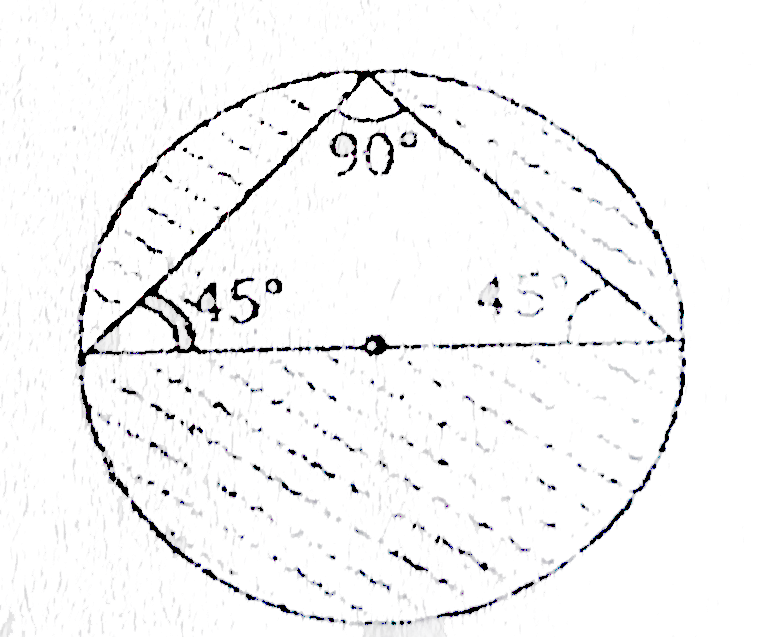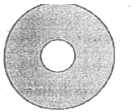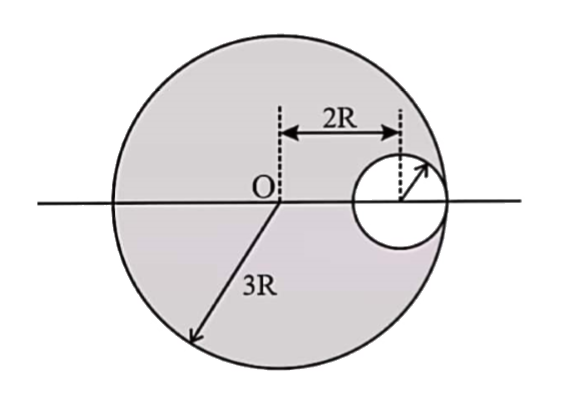From a uniform circular disc of mass M and radius R a small circular disc of radius R/2 is removed in such a way that both have a common tangent. Find the distance of centre of mass of remaining part from the centre of original disc.
To find the distance of the center of mass of the remaining part of the disc from the center of the original disc, we can follow these steps:
Step 1: Understand the Problem
We have a uniform circular disc of mass M and radius R. A smaller circular disc of radius R2 is removed from it such that both discs have a common tangent. We need to find the distance of the center of mass of the remaining part from the center of the original disc.
Step 2: Determine the Mass of the Removed Disc
The mass of the original disc is given as M. The area of the original disc is:
Aoriginal=πR2
The area of the smaller disc (removed part) is:
Aremoved=π(R2)2=πR24
Since the mass is uniformly distributed, the mass of the removed disc Mremoved can be calculated using the ratio of the areas:
Mremoved=M×AremovedAoriginal=M×πR24πR2=M4
Step 3: Position of the Centers
- The center of the original disc is at the origin (0,0).
- The center of the removed disc is located at (R2,0).
Step 4: Calculate the Center of Mass of the Remaining Part
The center of mass xcm of the remaining part can be calculated using the formula:
xcm=Moriginal⋅xoriginal−Mremoved⋅xremovedMoriginal−Mremoved
Substituting the values:
- Moriginal=M
- xoriginal=0
- Mremoved=M4
- xremoved=R2
Thus,
xcm=M⋅0−M4⋅R2M−M4=−MR83M4=−R6
Step 5: Conclusion
The center of mass of the remaining part of the disc is located at (−R6,0). The distance from the center of the original disc is R6.
Final Answer
The distance of the center of mass of the remaining part from the center of the original disc is R6.
---
We have a uniform circular disc of mass M and radius R. A smaller circular disc of radius R2 is removed from it such that both discs have a common tangent. We need to find the distance of the center of mass of the remaining part from the center of the original disc.
The mass of the original disc is given as M. The area of the original disc is:
Aoriginal=πR2
The area of the smaller disc (removed part) is:
Aremoved=π(R2)2=πR24
Since the mass is uniformly distributed, the mass of the removed disc Mremoved can be calculated using the ratio of the areas:
Mremoved=M×AremovedAoriginal=M×πR24πR2=M4
- The center of the original disc is at the origin (0,0).
- The center of the removed disc is located at (R2,0).
The center of mass xcm of the remaining part can be calculated using the formula:
xcm=Moriginal⋅xoriginal−Mremoved⋅xremovedMoriginal−Mremoved
Substituting the values:
- Moriginal=M
- xoriginal=0
- Mremoved=M4
- xremoved=R2
xcm=M⋅0−M4⋅R2M−M4=−MR83M4=−R6
The center of mass of the remaining part of the disc is located at (−R6,0). The distance from the center of the original disc is R6.
The distance of the center of mass of the remaining part from the center of the original disc is R6.
Topper's Solved these Questions
- BOOK - AAKASH INSTITUTE ENGLISHCHAPTER - SYSTEM OF PARTICLES AND ROTATIONAL MOTIONEXERCISE - Assignment (Section - J) Aakash Challengers Questions13videos
SYSTEM OF PARTICLES AND ROTATIONAL MOTION
- BOOK - AAKASH INSTITUTE ENGLISHCHAPTER - SEMICONDUCTOR ELECTRONICS: MATERIALS, DEVICES AND SIMPLE CIRCUITSEXERCISE - Assignment (Section-D (Assertion and reason))5videos
SEMICONDUCTOR ELECTRONICS: MATERIALS, DEVICES AND SIMPLE CIRCUITS
- BOOK - AAKASH INSTITUTE ENGLISHCHAPTER - TEST 1EXERCISE - EXERCISE21videos
TEST 1
Similar Questions
A circular hole is cut from a disc of radius 6 cm in such a way that the radius of the hole is 1 cm and the centre of 3 cm from the centre of the disc. The distance of the centre of mass of the remaining part from the centre of the original disc is
View SolutionFrom a circular disc of radius R, a triangular portion is cut (sec figure). The distance of the centre of mass of the remainder from the centre of the disc is −
 View Solution
View SolutionFrom a circular disc of radius R, a square is cut out with a radius as its diagonal. The center of mass of remaining portion is at a distance from the center)
View SolutionFrom a circular disc of radius R a square is cut out with a radius as its diagonal . The distane of the centre of mass of the remainder from the centre of the disc is
View SolutionA circular metallic disc of radius R has a small circular cavity of radius r as shown in figure. On heating the system
 View Solution
View SolutionGiven a uniform disc of mass M and radius R. A small disc of radius R/2 is cut from this disc in such a way that the distance between the centres of the two discs is R/2. Find the moment of inertia of the remaining disc about a diameter of the original disc perpendicular to the line connecting the centres of the two discs
View SolutionA disc of radius r is cut from a larger disc of radius 4r in such a way that the edge of the hole touches the edge of the disc. The centre of mass of the residual disc will be a distance from centre of larger disc :-
View SolutionA disc of radius r is cut from a larger disc of radius 4r in such a way that the edge of the hole touches the edge of the disc. The centre of mass of the residual disc will be a distance from centre of larger disc :-
View SolutionThe figure shows a disc of radius 3R from which a circular hole of radius R is cut as shown in the figure. The distance of the centre of mass of the remaining object from the point O is
 View Solution
View SolutionFrom a uniform disc of radius R, a circular section of radius R/2 is cut out. The centre of the hole is at R/2 from the centre of the original disc. Locate the centre of mass of the resulting flat body.
View Solution

